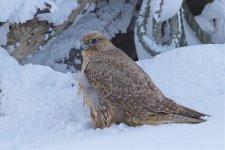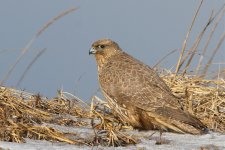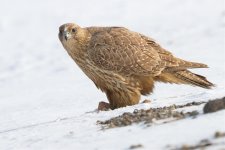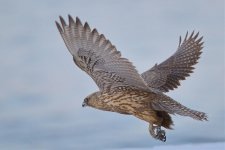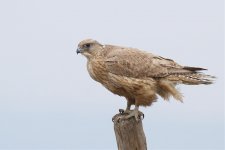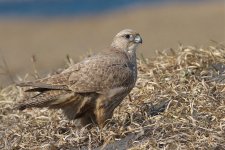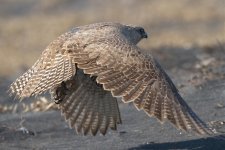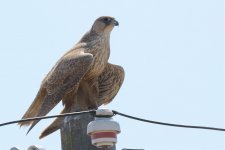If the bird has moulted it's feathers, then no, it would obvioiusly have new feathers but I have no idea what the moult strategy of a captive Falcon is likely to be, does it mirror wild bird moult cycles, Tom?
The tail on this bird looks quite short to me suggesting either old, damaged feathers or new, incomplete growth which shouldn't be so tatty so iId say it hasn't moulted it's tail in the 5 months?
A
I'm not Tom, but captive birds basically follow the same moulting timing as do wild birds.
This bird is a juvenile(1cy/2cy), and both wings and tail are not moulted until in the summer/autumn when the immature falcon acquires its first adult plumage.
However, the body feathers, as well as wing coverts, are being gradually (and with much individual variation) moulted even as early as from late in the first calendar year.
Since this bird was photograhed over an extended period in winter/early spring, the wings and tail of course remained unmoulted. These feathers, grown in the nest, would thus not be shed until well into the summer months, when the bird would be approximately one year old.
My point about possible captivity, is merely based on the fact that if you study museum skins, and/or good photos of large falcon in their first year (with juvenile remiges and retrices) you'd be hard pressed to find an individual with as brutal wear (broken tips of ALL 12 tail feathers) as this Japanese falcon exhibits.
This kind of wear, on the other hand, is seen very commonly on birds in captivity where birds fly against, and hang on to the wire mesh in an aviary. To keep their balance they press the tail against the wire mesh repeatedly, eventually causing all the otherwise extremely durable feather shafts to break.
This fact, together with the "un-Gyr-like" newly grown first adult wing coverts made me suggest a Saker x Gyr hybrid as much more likely than a confiding, atypically dirty/stained (look at the rusty brown belly and vent) Gyrfalcon with a highly atypical type of wing coverts AND with a broken tail......
Peter







